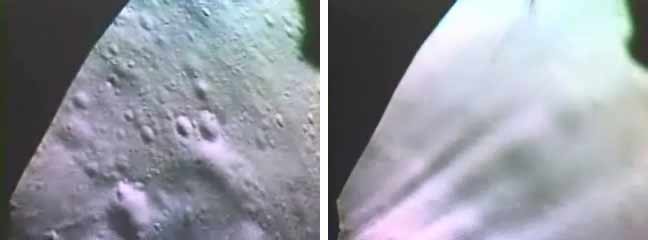How Lunar Landers Sandblasted the Moon

New research has revealed the seemingly gentle touchdowns of the six Apollo Lunar Modules (LMs) on the moon between 1969 and 1972 were actually incredibly violent events.
The Lunar Module's descent engine blew out high-velocity lunar particles that strafed the landscape.
"The smallest particles were seen by the Apollo astronauts to fly right out over the horizon and keep on going," said Philip Metzger of NASA's Kennedy Space Center (KSC). "Depending on the actual velocity they may have gone halfway around the moon or more. In most cases they would only travel until they hit a natural terrain feature, such as a crater rim or a mountain range."
These minute specks of lunar dust are estimated to have been propelled at speeds of between 0.6and 1.5 miles per second (up to 5,400 mph or 8,690 kph). That's nearly fast enough to escape the moon's gravity and enter orbit around the sun.
Better knowledge of the phenomenon will inform plans to put people and habitats on the moon.
Force in a vacuum
Pinning down the mechanics of these Apollo induced dust storms was achieved by Forrest Lumpkin at the Johnson Space Center together with Jacobs Engineering in Houston. Lumpkin and his team achieved the difficult task of simulating how the Lunar Module exhaust gases behaved in a vacuum.
Breaking space news, the latest updates on rocket launches, skywatching events and more!
A study of original Apollo landing footage undertaken by John Lane and Chris Immer, working for the ASRC Aerospace Corporation at the Kennedy Space Center, was also an essential factor in understanding just how a descending Lunar Module (LM) interacts with the lunar surface.
"New methods were developed to measure the shadows of the LM during its descent in the old Apollo landing videos," Metzger said. "From measuring these shadows, they have determined the shape of the blowing dust clouds under the LM. This is one of our main sources of experimental data on the ejection of soil by rocket exhausts."
The Apollo footage also shows that the blast from the LM engine gases were also powerful enough to move rocks up to 6 inches [15 centimeters] in size.
Surveying the damage
While the rocket exhaust may roll large rocks a short distance, it is the smaller particles that have the most widespread effect on the landing area.
This is clearly demonstrated by the damage inflicted on the Surveyor 3 unmanned craft, which rested only 600 feet (183 meters) from the descending Apollo 12 LM in November 1969.
Study of the Surveyor camera and mechanical scoop returned to Earth by the Apollo 12 astronauts revealed it had been sandblasted by lunar dust.
"There were what looked liked permanent shadows cast into the Surveyor," Metzger said. "Cosmic radiation in the lunar environment had darkened the surface of the Surveyor and then the spray of fine dust from the Apollo 12 LM removed that darkening wherever the spray could reach."
This same scouring process could easily damage the sensitive surfaces of future lunar hardware and fine lunar dust could also be forced into the interiors of surface equipment causing vital parts to jam.
"When the support collar was removed from the Surveyor camera, a small sample of soil and dust particles were found inside, where they had been injected through a small inspection hole that happened to be facing in the direction of the LM," Metzger said.
Such fine dust, around 10 microns in size, makes up the bulk of what was kicked up by the LM, but larger particles around 60 microns wide (the size of a very fine sand grain also made their mark on Surveyor 3 in the form of hundreds of micro-craters.
"The paint on the Surveyor camera shroud was fractured in a mud-cracking pattern," Metzger told SPACE.com. "Each intersection of cracks was at the location where a tiny particle had impacted, drilling a tiny cylindrical hole down into the paint and causing the fractures to spread out from there like spider-legs in a car windshield."
The particles that caused this damage are estimated to have been traveling at around 1,300 feet per second. The figure which ties in well with the expected velocity of particles blasted across the lunar surface by the LM engine just before touchdown. (Bullets exit a rifle at between 600 and 5,000 feet per second, or 180 and 1,500 meters per second.)
Protecting our interests
The sleet of particles shot at Surveyor 3 by just one nearby landing serves as a warning for humankind's return to the moon, and if spacecraft are to land near a future lunar outpost some precautions are going to have to be made. [Similar efforts are underway to figure out the effects of Mars landers.]
"We are currently investigating several different techniques. One idea is to use the natural terrain to block the spray between the landing site and the lunar outpost," Metzger explains.
"Another idea is to create an artificial terrain feature, a berm, around part of the landing site to block the spray in the crucial directions. It may also be possible to modify the landing surface to prevent the spray altogether."
- Top 10 Apollo Hoax Theories
- Top 10 Apollo Era Moon Discoveries
- VIDEO: Apollo 11: The First Moon Men
David Powell is a space reporter and Space.com contributor from 2006 to 2008, covering a wide range of astronomy and space exploration topics. Powell's Space.com coveage range from the death dive of NASA's Cassini spacecraft into Saturn to space debris and lunar exploration.
